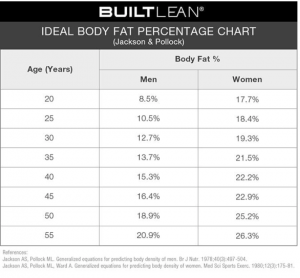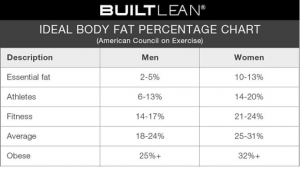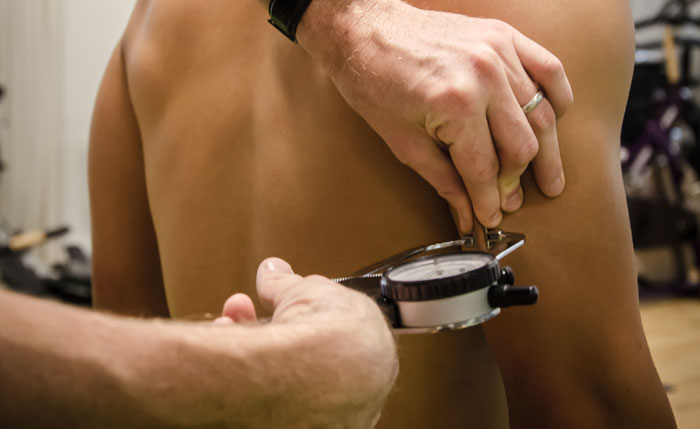What is body fat?
By definition:
“The body fat percentage (BFP) of a human or other living being is the total mass of fat divided by total body mass, times 100; body fat includes essential body fat and storage body fat. Essential body fat is necessary to maintain life and reproductive functions.” 1
I believe that body fat is an important measure of health, however, stating that a certain level of body fat is ‘unhealthy’ doesn’t give the whole story. Actually, some ‘overweight’ people who exercise can be healthier than their leaner ‘non-exercising’ counterparts.
Conversely, saying that someone who has a 6 pack (less than 8 % for males) who is athletic, and eats well is ‘underfat’ or ‘unhealthy’ is incorrect too.
What are the factors affecting body fat?
We all have different shapes, sizes and fat distribution profiles that are pre-determined by the following factors:
- Somatotypes
- Gender
- Age
However you can maximise your genetic potential and what you are physically capable of by controlling two very important factors that we all know about:
1. Diet
2. ExerciseBoth of these factors affect hormone levels. One of the most important factors with body fat % is insulin and whether you are insulin sensitive or insulin resistant.Somatotypes
An ectomorph is a typical ‘skinny’ person. ‘Ecto’s’ have a light build with small joints and lean muscle. Usually ectomorph’s have long thin limbs with stringy muscles. Shoulders tend to be thin with little width and they can often find it difficult to gain muscle & fat.
The mesomorph has a large bone structure, large muscles and a naturally athletic physique. Mesomorphs are the best body type for bodybuilding. They find it quite easy to gain and lose weight. They are naturally strong which is the perfect platform for building muscle and can easily fluctuate their body fat levels.
The endomorph body type is solid and generally soft. Endomorphs gain fat very easily. Endo’s are usually of a shorter build with thick arms and legs. Muscles are strong, especially the upper legs. Endomorphs find they are naturally strong in leg exercises like the squat.


Gender
As you can see, women have a higher body fat % relative to men for a given level.
Women have more fat because of physiological differences such as hormones, breasts and sexual organs.
In addition, women need a higher amount of body fat for ovulation.
The following chart provides an ‘ideal’ level of body fat % based on age and gender.

Age
As we age, the body tends to store more fat due to lowered metabolism and hormonal changes.
After the age of 30, the body tends to lose lean tissue. The muscles, liver, kidney, and other organs may also lose some of their cells. The bones may lose some of their minerals and become less dense (osteoporosis). Tissue loss reduces the amount of water in your body.
As a result, the amount of body fat increases steadily after 30.
During pregnancy, a woman gains fat due to the changes that take place in her body.
While men often gain weight until about age 55, women gain weight until 65.
So we are limited by our predisposing factors above but…
“How can I maximise my own genetic potential?”
You can still make the most of what you are capable of and set yourself some strong targets.
The variables you can control are the following:
1. Exercise
Generalised tips to reduce body fat %
– Completing 3 + resistance sessions / week.
– Completing 2 – 3 cardio sessions / week.
– Incidental activity: Improving your physical activity during the day at your occupation, mode of transport (car vs walking) and activities at home will enhance incidental activity.
Your training history/age will determine your level of body fat % and the rate at which you can lose body fat too (see below training for 12 months +)
2. Diet
There is no one size fits all approach for everyone. Different nutrition strategies work well for different people:
Generalised tips to reduce body fat %
– High Protein / Low Carbohydrate diet
– Eat carbohydrates around your training times only and avoid refined carbohydrates.
– Eat protein and fats for breakfast
– Aim for 5 x serves of green leafy vegetables / day
– Avoid gluten and limit dairy
Overall this will increase your metabolism and enhance your insulin sensitivity.
3. Hormones
Being insulin resistant is a bad thing, while being insulin sensitive is good.
You are insulin sensitive if a small amount of insulin needs to be secreted to deposit a certain amount of glucose and insulin resistant if a lot of insulin needs to be secreted to deposit the same amount of glucose.
When insulin levels are high this means that the rate of body fat storage are also high.
This is the same for the hormone cortisol which is the ‘stress’ hormone. When this is elevated it can cause excess body fat storage.
Over the long term, aerobic exercise done routinely can preserve beneficial changes in insulin sensitivity.2 Strength exercises are also associated with increasing insulin sensitivity as well as increased muscle mass 2.
How much body fat loss is appropriate over time?
Per week:
Guidelines for weight loss state that you should plan to lose .5 – 1kg of weight per week, but no such comprehensive guidelines for rate of body fat loss exist. This is obviously a figure for those who are new to exercise and have higher rates of weight to lose. 3
Per month:
Experts at the American Council on Exercise agree that a 1 % loss of body fat per month is safe and achievable for most. Since many methods to measure body fat are error prone they recommend only checking your progress every one to two months. Weight loss alone does not indicate fat loss. 3
12 months +:
When someone unfit begins a training regime, fitness levels improve rapidly but as they become fitter, the returns diminish. That is, as you become fitter, the amount of improvement is less as you approach your genetic limits. Therefore – expect to see big results early but in order to keep on losing body fat % you will need to come up with different training methods and programs that challenge your body to continually adapt.
The following graph also determines the appropriate level of body fat % based on your overall training age and history.

Measuring Body Fat %
There are a few methods to measure body fat. The most common method is the skin fold test, based on the assumption that 50 percent of body fat is under the skin. These measurements are used to calculate overall body fat. A BOD POD and bioelectrical impedance devices can also be used.
Assessing Progress Between Body Fat Measurements
Body fat % should only be measured once every one to two months, however there are other methods to assess progress in between. Another way to assess progress is to take measurements. Using a tape measure, measure around the chest, waist, hip & thigh once every one to two weeks. Measurements should decrease as you lose fat. Neither of these methods will tell you how much body fat has been lost, but they can show that you are moving in the right direction. We also like to use photos and also strength results as a measure of progression
Good luck – use this information to work out based on your predetermined factors what is a realistic target for YOU.
Dan Maitland – Owner
info@trainingwithmates.com.au
References
1 Bastard JP, et al. Recent advances in the relationship between obesity, inflammation, and insulin resistance . Eur Cytokine Netw. (2006)
2 Fisher G, Hunter GR, Gower BA. Aerobic exercise training conserves insulin sensitivity for 1 yr following weight loss in overweight women . J Appl Physiol. (2012)
3 Exercise AC. Ace Lifestyle & Weight Management Consultant Manual, The Ultimate Resource for Fitness Professionals. American Council on Exercise; 2009.
4 Gallagher D, Heymsfield SB, Heo M, Jebb SA, Murgatroyd PR, Sakamoto Y. Healthy percentage body fat ranges: an approach for developing guidelines based on body mass index. Am J Clin Nutr. 2000;72(3):694-701.
5 Flegal KM, Kit BK, Orpana H, Graubard BI. Association of all-cause mortality with overweight and obesity using standard body mass index categories: a systematic review and meta-analysis. JAMA. 2013;309(1):71-82.

